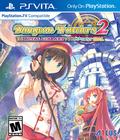Dungeon Travelers 2: The Royal Library & the Monster Seal is actually the sequel to a video game adaptation of a Japanese-only visual romance novel called To Heart 2. Both the original novel and the first game were never translated, which makes it surprising that we're getting the sequel. Luckily, DT2 is entirely stand-alone. Characters make jokes and references to the previous game, but you don't need to have played Dungeon Travelers or read To Hearts 2 to understand what's going on.
Players control Fried (pronounced freed), who works at the aforementioned Royal Library. His job is to hunt down monsters, who in this setting are "monster musume" or monster girls, and seal them into books. Monsters have begun terrorizing the land, and Fried discovers they are attacking shrines that house the spirit of an evil demon lord who will ravage the world if released. It's up to Fried and the Royal Library to stop the destruction of the seal and save the world.
Like many Vita games, DT2 depends heavily on tawdry fan service, but all of the characters seem bored when you get to one of the wacky antics. Characters have their clothes shredded or walk in on people naked, and while the game flashes some distinctly non-PG-rated imagery, none of the characters pay it much mind. You can't ignore it if that sort of material makes you uncomfortable, but it does make one question why it's in the game when the characters don't even seem to care. Unfortunately, it also treads into some really creepy territory that is likely to turn away people. The core plot is silly, and your enjoyment depends entirely on whether you like the characters.
Fried is not a fighter, so recruit a cast of heroines who do the fighting for him. At first blush, one might assume that this limits what you can do, but there's a fair bit of variety. Every character class has multiple upgrade trees. When you hit level 15, you can swap out to two different classes, each focusing on a specialization of the default class. (Some classes have more than two options.) For example, the fighter can become a paladin (increased defensive and protective skills) or a berserker (increased combat skills). Upgraded classes give you a second skill tree, so if you want your magic user to become a healing class, she still has access to the original combat spells but loses the ability to get AoE damage spells. You can get multiples of the same class, but each girl has a distinct ability.
It's a simple but effective system that works well. You can't make every character fill every role, but you're not obligated to leave characters in a role that works against your party composition. If you want to use the Scout character, she can be a back-row archer or a front-line assassin, both of which are equally viable. There are some cases where one class is better than another, but you're never locked into a class. At any time in the game, you have the ability to reset your character's level. At first, you can only reset to Level 1, but later on, you can reset at level 15, 30, 50 and eventually 90. The nice thing about this is that resetting to a level resets all your skill points. As soon as you hit level 15, you can rebuild your character. It encourages you to keep going with a somewhat suboptimal build rather than making you re-level your character from scratch. All class changes are also reset, so you can reconfigure your party.
Combat is the traditional JRPG style, with players and enemies taking turns hitting each another in turn-based combat. There's an action meter, so players and enemies act on the same turn based on their speeds, similar to Final Fantasy X. Faster characters can have more actions. As in most games of this type, frontline fighters take and deal more damage than backline fighters, and sine weapons only having full effect in certain rows. With joint attacks, you can use multiple party members to perform special moves. The moves depend on your party composition and can be anything from a full-party enemy identification to special attacks.
Keeping control of magic is important because it's incredibly powerful in Dungeon Travelers. Many people who played the demo were quickly wiped out by powerful enemies, and a good chunk of that was due to magic. Certain bosses can obliterate your entire frontline with a single spell, even if it's an otherwise fair battle. It's essential that your team is prepared; you need abilities that can interrupt enemies, prevent them from casting, or a team that's set up to funnel damage to characters who can handle it.
DT2 has an interesting way of handling money. Enemies drop extremely small amounts of cash but a lot of loot. Most loot is semi-randomized and has to be returned to the base to be identified. A lot of it is trash that you can sell to turn a profit, which can be spent on expensive healing and support items to make your quest easier. You can also take on quests for money and loot, but they're also semi-randomized and not much more dependable than grinding for loot.
The Sealbook system is a great addition. Once you've sealed enough monsters, you can convert them into a sealbook, which you can equip on characters for powerful passive boosts or sell for tons of cash. It's an interesting system in that grinding enemies has a coherent endgame. You know exactly how many you need to kill for a specific item and that item always has worth. Boss characters can be converted into grand sealbooks, which can't be sold but can be equipped on Fried to give your entire party a passive buff. Creating sealbooks also gives you information on that enemy when you encounter them for the duration of the game.
If there is one problem with DT2, it is the pacing. The game is extremely slow to get off the ground. It takes you a long while to get a full team and even longer for that team to feel really effective. It doesn't help that you're initially given relatively weak classes. You also get very low amounts of SP early on, you don't unlock subclasses until level 15, and the first few dungeons feel repetitive and tedious.
The difficulty level also can vacillate pretty wildly. You can end up feeling absurdly overpowered one moment and get utterly wrecked the next without much rhyme or reason. There are dungeons where the regular enemies hit like wifflebats, but the boss can one-shot your tank character, and there are dungeons where the regular enemies are bizarrely tough but the boss is a breeze. Since you start with weak characters in bad classes, it can make the game feel a lot harder than it actually is.
The dungeon design is good, if fairly basic. You'll find familiar dungeon crawler tricks, like locked doors, pitfalls, shortcuts, spiked traps and teleporters. Every dungeon is designed with the idea that you'll go a little further each time. When compared to something like Etrian Odyssey, the random encounter rate is a little high and the rate of shortcuts a little low. The game has a set of story dungeons and some extra-hard optional dungeons that you can take on with a party, so there's quite a bit of content. Finishing the game doesn't mean you've seen everything, and some late-game bosses can be brutally difficult if you're unprepared.
The graphics in DT2 are rather basic. The environments are nice, but the combat consists of static artwork with some simple animations. The character art is bright and colorful but often borderline obscene. There's also some remarkably lazy design work, such as the game's version of a skeleton, which is a girl wearing a t-shirt with a skull on it. It does its job well enough and looks a bit better than games like Demon Gaze, but the visuals are unimpressive. However, the soundtrack is quite good and has some catchy songs. The voice work is entirely in Japanese and can be customized to have everyone's voice or just the girls speaking.
Dungeon Travelers 2: The Royal Library and the Monster Seal is a perfectly fun dungeon crawler. It doesn't do anything exceptional, but it does everything it needs to do. The game is utterly shameless, and it's likely to drive away potential players due to the amount of almost-not-M-rated content that it contains. If that doesn't scare you off, DT2 is one of the more accessible dungeon crawlers on the Vita because it balances difficulty and ease of play. The heavy sexual content is the only barrier, so it's unfortunate that's it's rather significant, especially given some of the subject matter.
Score: 7.0/10
More articles about Dungeon Travelers 2: The Royal Library & the Monster Seal










 Dungeon Travelers 2: The Royal Library & the Monster Seal is a Japanese role-playing game for devotees of dungeon crawlers.
Dungeon Travelers 2: The Royal Library & the Monster Seal is a Japanese role-playing game for devotees of dungeon crawlers.




